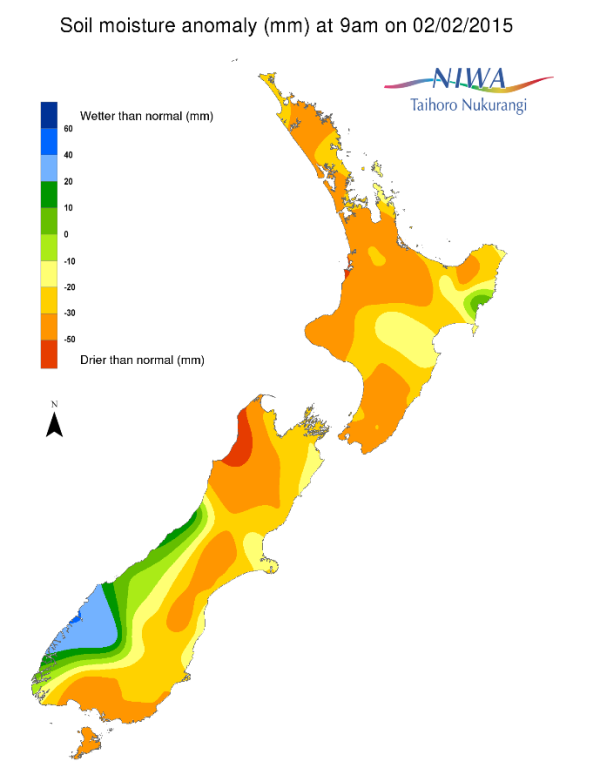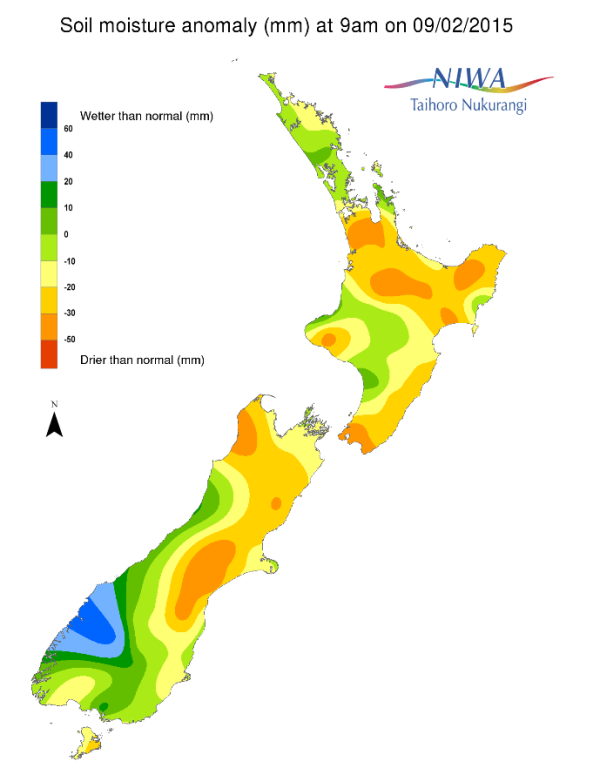Facts: Soil Moisture
For the North Island, soil moisture levels remain much drier than normal for this time of year in the Waikato and Wairarapa regions as well as parts of Gisborne and Hawke’s Bay. Pockets of severely to extremely drier than normal soil moisture persist in the Waikato, Opotiki, South Wairarapa and South Taranaki districts.
For the South Island, the continued lack of significant rainfall over northeastern parts of the island has meant that severely to extremely drier than normal soil moisture levels for this time of year remain in the Canterbury region. Much drier to severely drier than normal soils are also characteristic of the Nelson, Marlborough and Tasman regions.
Week-to-Week Comparison
When compared to this time last week there has been considerable improvement in soil moisture conditions in many parts of the country. In the North Island, rainfall over Northland, Taranaki and coastal Wanganui has seen the replenishment of soil moisture levels which are now in the near normal range. Other parts of the island have not been as fortunate. Limited rainfall since last week has meant that the Waikato and Wairarapa regions as well as parts of Gisborne and Hawke’s Bay remain much drier to extremely drier than normal. In the South Island, significant rainfall over the hotspot Otago region and Southland has brought about a welcome reprieve with near normal to just below normal soil moisture now extending over the region. An improvement in soil moisture levels from last week is also evident over the Nelson, Marlborough and Tasman regions, however soils are still severely drier than normal.
Commentary
For the North Island, when considering the current soil moisture anomalies for this time of year, the Waikato and Wairarapa regions are a hotspot as soils in this region have been severely to extremely drier than normal for several weeks. Soils in parts of Gisborne and the Hawke’s Bay also continue to be much drier to extremely drier than normal, despite some rainfall over the regions in the past week. Soil moisture in northern Auckland and Northland was being previously monitored for hotspot development but is now in the near normal range for the time of year.
For the South Island, a hotspot continues to exist throughout Canterbury. Rainfall over Otago over the past week has seen this hotspot region recover significantly in terms of soil moisture but will need to continue to be monitored. The far north of the island from the eastern Tasman region to the western Marlborough region also continues to be a hotspot, despite some improvement in soil moisture levels over the last week.
For hotspot regions, sustained rainfall over an extended period of time is needed to return conditions back to normal.
Background:
Hotspot Watch a weekly advisory service for New Zealand media. It provides soil moisture and precipitation measurements around the country to help assess whether extremely dry conditions are imminent.
Soil moisture deficit: the amount of water needed to bring the soil moisture content back to field capacity, which is the maximum amount of water the soil can hold.
Soil moisture anomaly: the difference between the historical normal soil moisture deficit (or surplus) for a given time of year and actual soil moisture deficits.
Definitions: “Extremely” and “severely” dry soils are based on a combination of the current soil moisture status and the difference from normal soil moisture (see soil moisture maps at https://www.niwa.co.nz/climate/nz-drought-monitor/droughtindicatormaps)
Pictured below: Soil Moisture Anomaly Maps, relative to this time of year. On the left are values this time last week. On the right are the most recent values.



